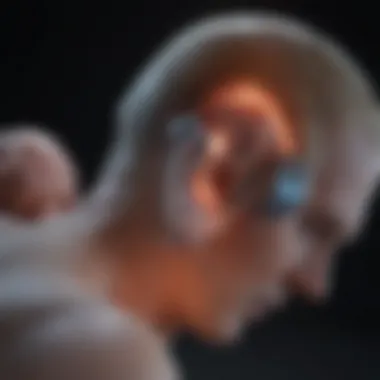Exploring TMS Therapy for Tinnitus Treatment


Intro
Tinnitus is a complex auditory condition that affects millions of people worldwide. Those who experience tinnitus often describe it as persistent ringing, buzzing, or hissing in the ears. For some, it can be a minor nuisance, while for others, it is a significant disruption that impacts daily life. The quest for effective treatment options has led to the exploration of various therapies, including a cutting-edge approach called Transcranial Magnetic Stimulation (TMS).
TMS therapy offers a non-invasive method of modulating brain activity through magnetic fields. This article aims to provide a comprehensive overview of how TMS can be utilized in the management of tinnitus. We will delve into the clinical research surrounding this therapy, its mechanisms of action, efficacy, current trends, and clinical implications.
Research Overview
Methodological Approaches
Additionally, observational studies help in understanding the long-term effects of TMS on tinnitus patients. Using metrics such as the Tinnitus Handicap Inventory, researchers can quantify the changes in perception and severity of tinnitus before and after treatment. Cooperating with institutions, researchers can gather data that illustrates the broader implications of TMS in clinical practice.
Significance and Implications
"TMS therapy represents a promising frontier in tinnitus research, with the potential to offer relief to those suffering from this challenging condition."
The significance of this research lies not only in its applicability but also in promoting awareness of tinnitus as a serious health concern. The results fuel patient advocacy for newer treatment methodologies, encouraging them to explore options like TMS.
Current Trends in Science
Innovative Techniques and Tools
Recent advancements in TMS technology have made it more accessible and efficient. The development of targeted TMS systems allows practitioners to focus on specific brain regions implicated in tinnitus perception. Moreover, the advent of real-time imaging techniques like fMRI enables better mapping of brain activity, enhancing the precision of TMS applications.
Interdisciplinary Connections
In summary, TMS therapy holds promise as a forward-looking treatment for tinnitus. Ongoing research and evolving methodologies suggest a continual improvement in the understanding and management of this pervasive auditory ailment.
Understanding Tinnitus
Understanding tinnitus is essential for grasping the significance of TMS therapy in managing this condition. Tinnitus is not merely a ringing in the ears; it is a complex auditory phenomenon that can affect anyone. Providing clarity on the nature of tinnitus allows for a deeper appreciation of why effective treatments, like TMS, are necessary. Recognizing symptoms, causes, and implications of tinnitus contributes to informed treatment decisions.
Definition of Tinnitus
Tinnitus refers to the perception of sound that has no external source. It can manifest as various sounds, including ringing, buzzing, hissing, or chirping. This auditory sensation can be intermittent or constant, varying in intensity and duration. Importantly, tinnitus itself is not a disease but a symptom that may arise from diverse underlying conditions. Conditions such as hearing loss, exposure to loud noises, or ear infections can trigger tinnitus. To understand tinnitus thoroughly, one must also consider its multifaceted nature and the personal experience associated with it.
Common Causes and Risk Factors
Several factors contribute to the development of tinnitus. Understanding these common causes is vital in addressing the condition. Factors include:


- Hearing Loss: Age-related hearing loss, often referred to as presbycusis, is a significant contributor.
- Noise Exposure: Long-term exposure to loud sounds can damage the hair cells in the inner ear.
- Ear Infections: Infections can lead to inflammation, affecting auditory pathways.
- Medications: Certain medications may have tinnitus as a side effect. Common culprits include aspirin and some antibiotics.
Additionally, lifestyle choices such as smoking, alcohol consumption, and stress can exacerbate symptoms. Understanding these risk factors not only helps in mitigating the condition but also in developing effective treatment plans.
Impact on Quality of Life
The impact of tinnitus extends beyond mere annoyance; it can significantly impair quality of life. Individuals may experience disturbing symptoms leading to:
- Insomnia: Difficulty in sleeping due to persistent sounds.
- Anxiety and Depression: The constant presence of tinnitus can lead to mental health challenges.
- Concentration Issues: Affected individuals may find it hard to focus in quiet environments.
"Tinnitus affects everyone's life differently, but its pervasive nature can lead to distress and frustration."
Consequently, understanding how tinnitus affects daily living is crucial. Addressing these challenges can vastly improve the quality of life, showcasing the importance of effective treatment options such as TMS therapy. By consolidating knowledge about tinnitus, one can take proactive steps towards management and recovery.
Exploring TMS Therapy
Understanding TMS therapy is crucial in grasping its potential benefits for individuals suffering from tinnitus. As research expands, TMS therapy emerges as a promising option for managing this condition that continues to perplex many. The ability of TMS to directly influence brain activity signifies a shift in how tinnitus can be approached in treatment.
What is Transcranial Magnetic Stimulation?
Transcranial Magnetic Stimulation is a non-invasive procedure that uses magnetic fields to stimulate nerve cells in the brain. This therapy is primarily utilized to treat conditions like depression, but its application has extended into other areas, including tinnitus. It works by positioning a magnetic coil near the scalp, which generates brief magnetic pulses targeting specific areas of the brain. These pulses can induce electrical currents in the neurons beneath the coil, potentially altering brain function and addressing the neural mechanisms involved in tinnitus perception.
Mechanism of Action
The mechanism of action of TMS is centered on its ability to modulate neuronal excitability. By delivering magnetic stimulation to targeted regions, particularly the auditory cortex, TMS aims to reset abnormal neural activity associated with tinnitus. This process may enhance the brain's capability to effectively process auditory information. Results from studies indicate that TMS may help in reducing the perception of ringing or buzzing noises in the ears experienced by tinnitus patients.
The impact of TMS therapy can be understood through different models, such as the inhibitory and excitatory modulation of cortical neurons. This modulation modifies the synaptic connections in the brains of tinnitus patients, leading to a potential decrease in the symptom's intensity. Thus, understanding the precise mechanism helps clinical professionals tailor TMS therapy protocols for individualized care.
Comparison with Other Treatment Modalities
TMS therapy differs from other common tinnitus treatments, such as cognitive behavioral therapy and sound therapy, in several respects. Here's a brief comparison:
- Cognitive Behavioral Therapy: Focuses on modifying negative thoughts and behaviors related to tinnitus. While effective for some, it does not directly target the auditory cortex.
- Sound Therapy: Involves the use of external sounds to mask the tinnitus. This approach offers temporary relief but does not address the root cause of the problem.
- TMS Therapy: Unlike these modalities, TMS targets the physiological factors of tinnitus, which may result in a more long-term alleviation of symptoms. It aims to correct the neuronal activity patterns without requiring continuous external stimuli.
Together, the unique qualities of TMS therapy position it as a complimentary approach, warranting further investigation in larger-scale studies. Though still under exploration, its direct intervention in brain functions proves valuable in the comprehensive treatment of tinnitus.
"TMS offers a new frontier in the understanding and treatment of tinnitus, suggesting there are mechanisms within the brain that can be modified to enhance patients' quality of life."
As research progresses, TMS therapy could reshape treatment frameworks and provide hope to those impacted by tinnitus.
Research Insights


Research into Transcranial Magnetic Stimulation (TMS) therapy for tinnitus is crucial. Understanding this topic can reveal how TMS may offer new hope for individuals suffering from this frustrating auditory condition. The significance of research insights spans multiple dimensions, including methodological rigor, clinical applicability, and the formulation of evidence-based treatment strategies. By dissecting current investigations, we uncover the potential benefits of TMS and the considerations researchers must address to enhance patient outcomes and care protocols.
Clinical Studies on TMS and Tinnitus
The methodology typically involves applying TMS to specific areas of the brain believed to be involved in auditory processing and tinnitus perception. For instance, stimulation of the dorsolateral prefrontal cortex has shown particular relevance in some studies. Results indicate that many patients experience reductions in the loudness of their tinnitus and improvements in associated distress levels. Nevertheless, not all individuals respond favorably, underlining the heterogeneity of tinnitus as a condition.
Efficacy Rates and Findings
Efficacy rates reported in studies are mixed. Some research presents data indicating significant improvements in tinnitus symptoms in about 30-50% of participants who underwent TMS treatment. These findings vary based on demographic factors, the duration of tinnitus, and the specific TMS protocol used. While these statistics offer hope, it is essential to approach these figures with caution. Not all studies are of equal quality, and methodological differences can lead to divergent results.
Additionally, the subjective nature of tinnitus perception complicates the assessment of efficacy rates. Patients may respond differently to TMS, and self-reported measures largely inform efficacy evaluations. These subjective aspects play a critical role in the determination of effective treatment options, making comprehensive and prolonged follow-up essential for accurate assessments.
Limitations of Current Research
Moreover, the long-term effects of TMS therapy remain relatively unexplored. Questions regarding sustainability of symptom relief over extended periods are vital for establishing TMS as a reliable treatment option.
In addition to these challenges, it can be difficult to discern the true mechanisms behind TMS’s therapeutic effect on tinnitus. Future research should aim to illuminate these aspects, potentially informing more effective treatment methodologies.
"TMS represents a novel approach with the potential to shift the paradigm of tinnitus management, yet more definitive research is necessary to validate these findings and their applicability to broader patient populations."
Practical Aspects of TMS Therapy
Understanding the practical facets of TMS therapy is essential for both patients and the medical community. This section aims to clarify who can benefit from TMS therapy, the protocols involved, and the associated risks and side effects. Each of these areas plays a pivotal role in determining the viability of TMS as a treatment option for tinnitus, offering insights that help in making informed decisions.
Who Can Benefit from TMS Therapy?
Not every patient with tinnitus may be suitable for TMS therapy. Generally, candidates include those who experience persistent and bothersome tinnitus that significantly impacts their daily lives. Individuals who have not found relief through conventional treatments, such as hearing aids or sound therapy, are also potential beneficiaries. It is particularly valuable for adults who are not candidates for surgery or have conditions that make invasive procedures risky.
Patients with specific neurological conditions may have varied responses to TMS. Thus, people should consult with healthcare professionals to evaluate their individual conditions before proceeding with TMS therapy. Some conditions that warrant careful consideration include:
- Seizure disorders
- Brain injuries
- Implanted medical devices
Treatment Protocols and Sessions
The typical process includes the following steps:
- Initial Evaluation: A thorough assessment by a healthcare provider is necessary to determine eligibility.
- Session Setup: Patients are guided to a chair, where a coil is placed near the head.
- Magnetic Pulses: During the session, short magnetic pulses are administered to stimulate the brain regions involved in auditory processing.
- Aftercare: Patients are monitored briefly post-treatment to observe for any immediate side effects.
The adherence to treatment protocols is vital, as it helps maximize the efficacy of the therapy. Each patient's response is unique, and continuous monitoring allows for adjustments as needed through the course of treatment.


Risks and Side Effects
Though TMS therapy is generally considered safe, some patients may experience side effects. Most side effects are mild and temporary. Common symptoms include:
- Headaches
- Scalp discomfort
- Dizziness
These symptoms usually dissipate shortly after the session. More serious risks such as seizures are rare but can occur in individuals with a known history of seizures or those at increased risk. Therefore, pre-screening is crucial.
Patients should discuss any concerns with their healthcare provider before starting TMS therapy. Understanding the benefits and risks allows for a more informed decision-making process.
The potential of Transcranial Magnetic Stimulation (TMS) therapy in addressing tinnitus represents an evolving frontier in auditory medicine. This future not only denotes advancements in the technology but also the broader understanding of the underlying mechanisms of tinnitus. As new research continues to unfold, the implications could lead to more refined treatment protocols, enhanced patient selection, and an overall improved quality of life for those suffering from this challenging auditory phenomenon.
Emerging Trends and Innovations
The landscape of TMS therapy is observing several emerging trends that may reshape its application in tinnitus management. One significant trend is the integration of neuroimaging technologies, such as fMRI and EEG, to tailor TMS treatments based on a patient’s unique neurological profile. This individualized approach could increase the efficacy of TMS by targeting specific brain regions determined to be dysfunctional in relation to tinnitus.
Another trend involves the development of novel TMS protocols. Researchers are exploring various stimulation frequencies and durations to optimize therapeutic outcomes. For example, low-frequency TMS appears promising for modulating hyperactive neural circuits associated with tinnitus. In addition, combination therapies that include TMS with cognitive behavioral therapy (CBT) or sound therapy may produce synergistic effects, enhancing overall treatment success.
Ongoing Research Initiatives
Multiple research initiatives are currently investigating the long-term effects of TMS on tinnitus. Large-scale clinical trials aim to gather robust data on the effectiveness of TMS, assessing not only the reduction in tinnitus loudness but also the improvement in associated symptoms such as anxiety and depression. The objective is to clarify whether TMS can offer a sustainable solution or if effects diminish over time.
Research teams are also focused on understanding the mechanisms of action behind TMS therapy and its neurophysiological impacts. Studies explore how TMS affects neurotransmitter levels and neural plasticity, providing insights that could guide future adaptations in treatment strategies. This ongoing inquiry is crucial, as establishing a well-defined mechanism will foster confidence in TMS as a legitimate therapeutic option in the medical community.
Patient Perspectives and Experiences
The reception of TMS therapy among patients is also an aspect of its future that demands attention. Early reports indicate that patients often perceive significant relief from tinnitus symptoms, fostering hope and a sense of control over their condition. However, experiences vary widely; some patients report minimal effect, highlighting the need for a deeper understanding of who is most likely to benefit from TMS therapy.
Feedback from patients is essential to refine treatment protocols and address concerns. Engagement with patient communities on platforms such as Reddit and Facebook can provide valuable insights and help shape future research directions. Their testimonies can inform healthcare providers about the practical aspects of receiving TMS therapy, including treatment expectations, side effects, and overall satisfaction. By prioritizing patient-focused research, the medical community can ensure that TMS therapy evolves in a way that maximizes benefits for the people it aims to help.
Ending and Recommendations
Summary of Key Insights
TMS therapy introduces an innovative approach in addressing tinnitus. Key insights include:
- Mechanism of Action: TMS utilizes focused magnetic fields to stimulate specific brain regions. This modulation can help in alleviating the perception of tinnitus.
- Efficacy: Research indicates varying degrees of effectiveness, with some patients noting significant improvements in their tinnitus symptoms.
- Ongoing Research: Continued studies are essential, as the understanding of TMS is still evolving. Emerging data may refine its application and effectiveness.
- Patient Perspectives: Experiences vary. Gathering qualitative data from patients may enhance the approach to care and suitability of TMS for individuals.
In summary, the potential of TMS in tinnitus management highlights a clearer path towards improvements in patient quality of life.
Guidance for Patients Considering TMS Therapy
For individuals contemplating TMS therapy, a few considerations are paramount:
- Consultation with Professionals: It is essential to seek advice from healthcare providers who specialize in tinnitus or neurological disorders. Their expertise can guide patients through the decision-making process.
- Understanding the Process: Familiarizing oneself with what to expect during TMS sessions can ease anxiety. Establishing a clear understanding of each step promotes informed consent and comfort.
- Potential Outcomes: Set realistic expectations. While some patients experience significant relief, results can vary considerably. It is important to remain open yet discerning regarding potential benefits.
- Monitoring Progress: Keeping a detailed journal of symptoms before, during, and after treatment can provide valuable insights into the effectiveness of TMS therapy.
- Consider Broader Treatment Options: TMS may complement other therapies. Evaluating all potential strategies for managing tinnitus is crucial.
In summary, TMS therapy presents a promising avenue for tinnitus management, warranting careful consideration and informed discussion between patients and healthcare providers.



